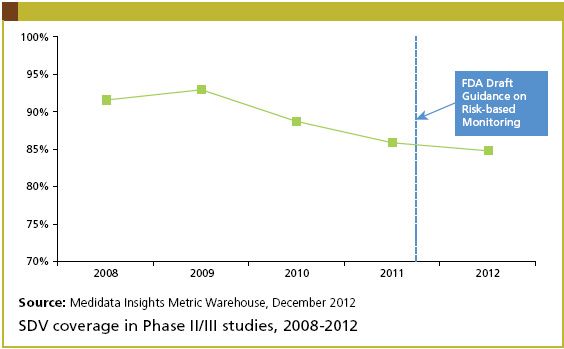Has the 2011 FDA Guidance on Risk-based Monitoring Impacted SDV Coverage Yet?
Over the past year and a half we have been monitoring the trend towards adoption of risk-based monitoring across the industry, and in particular the move towards reduced source document verification (SDV).
SPOTLIGHT EVENTRisk-Based Monitoring – Beyond Theory In-Depth ReviewMarch 13, 2014
Cambridge, MassachusettsDownload BrochureRegister
RELATED
- The Emergence of the Centralized Monitor
- Risk-Based Approaches
- ICON Exec Discusses ICONIK MonitoringMore in Risk-Based Monitoring
Over the past year and a half we have been monitoring the trend towards adoption of risk-based monitoring across the industry, and in particular the move towards reduced source document verification (SDV). One might anticipate an imminent inflection point towards broader adoption of this paradigm given the FDA draft guidance and EMA reflection paper issued in 2011, which both strongly endorse the approach.
This month's featured Insights metric shows the trend in SDV Coverage from 2008 through 2012. The graph reveals a 7% decrease over the past five years from 92% down to 85%. So while this trend indicates a steady movement in the direction of risk-based monitoring, the progress has been relatively modest to date. The anticipated inflection point has not materialized yet following the 2011 FDA and EMA endorsements, at least from the perspective of SDV coverage. We will continue tracking this metric - along with other relevant metrics - through 2013 and beyond, and we fully expect an increasing downward slope in the SDV coverage trend moving forward as organizations move from piloting to broad implementation of risk-based monitoring. Previous analysis (http://bit.ly/IaqetC), shows that less than three percent of clinical data entered needs correction. Therefore, inefficient quality control procedures like non-targeted and 100% SDV coverage merely add costs and delays to the progress of clinical trials.
The broad adoption of electronic data capture systems like Medidata Rave® is decreasing the need for reliance on on-site monitoring, a move that is supported by the FDA's guidance. Clinical R&D organizations should therefore consider remote, centralized monitoring approaches and supporting technology solutions that enable verification of eCRF data at lower costs, yet do not compromise data quality.
How can SDV coverage be further decreased without impacting data quality? As always, Medidata is interested to hear your take on this result. Please stay tuned as we continue looking into clinical operations data from the more than 5,200 recent clinical trials found in the Insights metrics data warehouse.
- Medidata Solutions, www.mdsol.com


Improving Relationships and Diversifying the Site Selection Process
April 17th 2025In this episode of the Applied Clinical Trials Podcast, Liz Beatty, co-founder and chief strategy officer, Inato, discusses a number of topics around site engagement including community-based sites, the role of technology in improving site/sponsor relationships, how increased operational costs are impacting the industry, and more.
Behind the Buzz: Why Clinical Research Leaders Flock to SCOPE Summit
February 7th 2025In this episode, we meet with Micah Lieberman, Executive Conference Director for SCOPE Summit (Summit for Clinical Ops Executives) at Cambridge Innovation Institute. We will dive deep into the critical role of collaboration within the clinical research ecosystem. How do we bring together diverse stakeholders—sponsors, CROs, clinical trial tech innovators, suppliers, patients, sites, advocacy organizations, investors, and non-profits—to share best practices in trial design, program planning, innovation, and clinical operations? We’ll explore why it’s vital for thought leaders to step beyond their own organizations and learn from others, exchanging ideas that drive advancements in clinical research. Additionally, we’ll discuss the pivotal role of scientific conferences like SCOPE Summit in fostering these essential connections and collaborations, helping shape the future of clinical trials. Join us as we uncover how collective wisdom and cross-industry partnerships are transforming the landscape of clinical research.
FDA-Approved Gene Therapy Beqvez Shows Sustained Efficacy, Safety in Long-Term Hemophilia B Trial
April 17th 2025Beqvez (fidanacogene elaparvovec), an FDA-approved one-time gene therapy for hemophilia B, demonstrated sustained factor IX expression, low bleeding rates, and a favorable safety profile over long-term follow-up.

